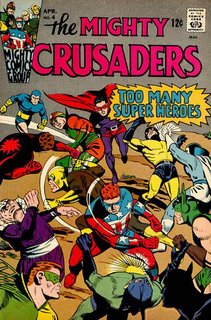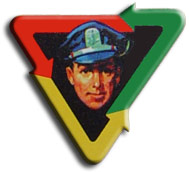
3. Mighty Crusaders #4: ”Too Many Super Heroes!”
By the time this comic book came out, the word was out that I loved the comic books. (Actually, with publishers dating comic books three months ahead of the month they are released, there is a very good chance that this comic, dated “April,” was actually released in January 1966, the month Batman premiered. With the word out, assorted relatives—well, probably just my mother and grandmother—started to buy them for me unbidden.
However, unless I was there, I had no assurance that I would be getting anything that I would actually want. I obtained many a Casper, Dennis the Menace, Hot Stuff, and Archie that way. Now, I admit that I looked at everything I was bought—and Istill have a fondness for Silver Age Casper and Hot Stuff—but given the choice, I would have chosen Doom Patrol over Casper's Ghostland any day.
Eventually, my family began to realize that it was super hero comic books that I really wanted. That resulted in an increase of Detective Comicsand Tales of Suspense coming into my possession. It also resulted in my seeing some less familiar super heroes like Gold Key’s Owl and Magnus.
(I’ll be honest and say that when I was a child I really disliked Gold Key comics that featured realistic humans, as opposed to cartoony humans like Elmer Fudd. I hated the covers, whether painted or, in the case of adaptations, repurposed publicity photos. I hated the stiff art and, when I learned how to read, I hated the stories because they felt pointless. I really only began to appreciate some of these comics within the last fifteen years beginning with Valiant’s reprinting Magnus, Robot Fighter and continues now with Dark Horse’s reprinting of Magnus , Doctor Solar, Man of the Atom, and M.A.R.S. Patrol Total War. If Dark Horse decides the market would support it, I’d like to see a reprinting of Space Family Robinson, which was Lost in Space long before the television series of that name was a twinkle in Irwin Allen’s eye. I still can’t bring myself to pick up the recent reprints of Gold Key’s Star Trek, though. This site provides the story of the relationship between the comic book and television series.)
As I was saying, I was beginning to see super heroes that didn’t come from Marvel or DC. It was during this time that I first looked at Mighty Crusaders #4; like the others, it was a comic that just appeared. I looked at it occasionally, but it never really sparked with me then. The comic languished in the comic book box, a big brown cardboard box in the closet where my brothers and I tossed the comics when we were told to put them away; I use proper comic boxes now, but still eschew the use of bags and boards.)
For anyone who hasn’t heard of this series or comic, Mighty Crusaders was published by Archie Comics under the guise of the Mighty Comics Group. During the Golden Age, MLJ Magazines—the company that would evolve into Archie Comics after the company realized which of their characters was buttering their bread—published straightforward super-hero comic books featuring the Shield, the Web, Hangman, the Comet, the Black Hood, and many others, but dropped them in favor of Archie and his friends by the end of World War II. In the late fifties, Joe Simon and Jack Kirby landed at Archie and produced two new comics, The Adventures of the Fly and The Double Life of Private Strong, the latter a reworking of the earlier Shield now in a Captain America mold.
By 1964, Jerry Siegel and Paul Reinman were working on the super hero line. In his writing, Siegel showed an amazing ability to predict trends as his stories were campy seven months before Batman was on television. He also, in what may have been an attempt to emulate the crossovers Stan Lee was doing at Marvel (in fact, a lot of the trappings of the Archie super-hero line at that time could be construed as having been crafted to copy Marvel), began reintroducing Archie’s Golden Age heroes. In his first issue (#31) of The Adventures of the Fly, now re-titled Fly-Man he brought back the Comet, the Black Hood, and what appeared to be the original Shield (he was actually his son). Those three, along with Fly-Man and Fly-Girl, formed a team, the Mighty Crusaders. After meeting for there for three more issues, the group was given its own title.
The story in Mighty Crusaders is incredibly simple, written by Siegel in his best “coincidence mode.” On the splash page, the Mighty Crusaders are gathering for a meeting, which is going to be broadcast on television, when an enemy attacks them. It is just the first of many such attacks from many different villains that were beaten back by the Crusaders and, my hand to God, every single super hero Archie published during the Golden Age. Alone and in pairs they arrived, for twenty-four pages, many choosing that day to come out of retirement, all of them demanding to join the Crusaders. In the end, none of them joined and the story ended as it began, with the Crusaders needing to hold their meeting.
In retrospect, I don’t know why I didn’t like this comic right away as it as everything I want to in a mainstream super-hero comic: action, soap opera melodrama disguised as character development, and the reintroduction of Golden Age super heroes. Thinking about the comic right now, I wish I had access to my copy so I could read it again, but at the time it did nothing for me. What changed my feeling toward the comic was that by the seventies I was reading books like All in Color For a Dime that introduced me to comic book history. Where else but Mighty Crusaders #4 could I actually see a clear picture of characters like Steel Sterling, Roy, the Mighty Boy, and Bob Phantom?
In that context, “Too Many Super Heroes!” retroactively became my “The Flash of Two Worlds”: It gave me access to “forgotten” characters in a way like no other comic I owned. I know that this comic is the one that helped foster my interest in the history of comic books and for “forgotten” characters, those characters published no longer or sporadically. To this very day, I am still a sucker for every character revival, JLA/JSA team-up, or reprint that comes down the pike and I know a great part of that is due to Mighty Crusaders #4; quite a feat for a comic I didn’t really have any opinion one way or the other when I first read it.

